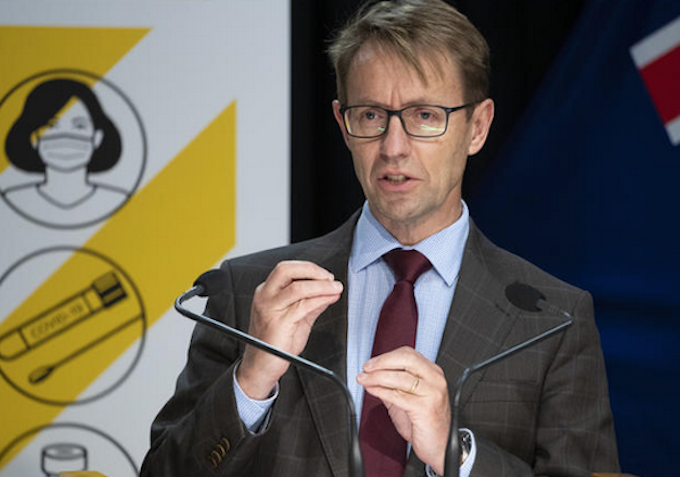New Zealand’s Director-General of Health, Dr Ashley Bloomfield, says covid-19 case numbers have passed their peak in Auckland, the country’s largest city, but that people should remain vigilant.
Dr Bloomfield said there were 20,907 new community cases of covid-19, a further 15 deaths and 1016 people in hospital in today.
He said the latest analysis showed covid-19 case numbers had passed their peak in Auckland, and were tracking down in all three district health boards.
Dr Bloomfield said that analysis also showed case numbers nationally — not including Auckland — were also slowing. They increased just 1 percent in the seven days to March 20, compared to a 44 percent increase in the week ending March 13.
The pattern did differ by DHB, with cases still increasing in the South Island, although there were encouraging signs they were peaking in the Midland region and in the Wellington region.
He said case numbers appeared to be largely now following the modelling for a high-transmission scenario. Case numbers were higher than the modelling suggested, and Dr Bloomfield said this may be because most cases in New Zealand were the BA.2 subvariant.
Hospitalisations in the northern region were also levelling off.
“We’re watching carefully and the expectation is that they will start to drop as the week progresses,” Dr Bloomfield said.
“The average length of stay for people on wards in the Auckland hospitals who have been discharged is now 3.2 days compared to just over two days last month, and the average stay in intensive care is five days.
“This increase in average length of stay reflects that we’re now seeing that people who are needing longer care, they may even be over their covid infection but they have symptoms that need to be managed, often from underlying conditions.”
Watch the update
Dr Bloomfield said that even though cases in hospital in Auckland were staying high, the number of new admissions each day was dropping quickly. But because those being admitted now were sicker and required longer care in hospital, the total number of people in hospital remained fairly steady.
Emergency department admissions testing positive remain highest at Middlemore, but they had fallen from 40 percent last month to 28 percent now. Auckland Hospital was down from 30 percent to 22 percent, while Waitematā was steady about 18 percent.
Whangārei’s ED positivity rate was still increasing, he said.
“Admissions in the rest of the country are growing and we will continue to see them grow.”
Dr Bloomfield said hospitalisation rates during the delta outbreak was about 8 percent, whereas the omicron outbreak had been about 0.9 percent.
“That hospitalisation rate will appear to increase over coming weeks, because as the cases drop yet people remain in hospital we’ll see the denominator decline much quicker … hospitalisations will decline but more slowly,” he said.
“The number of deaths each day is also likely to increase and will take longer to decline.”
He said staffing shortages were a major pressure on the health system, and there was real pressure in hospitals as well as care in the community, including rest homes.
‘Covid isn’t done with the world just yet’
Dr Bloomfield said New Zealand could expect ongoing waves of covid, and looking across the Tasman was instructive.
“The number of people hospitalised with covid in New South Wales never dropped below 950 after their first omicron wave … it’s now back over 1000 as cases started to increase again.
“In contrast, in Victoria the number of hospitalisations declined down to around 200 and remained steady there … so two quite different pictures.”
He said this showed New Zealand should expect to see a residual number of cases and people in hospital.
The UK had seen increased case numbers with the BA.2 subvariant, with Scotland hit hardest.
“Case numbers there are just below their previous peak, and hospitalisation figures the highest they have been since 2020. Globally it’s likely there will continue to be further waves of omicron and likewise there will be new variants of concern.”
He said New Zealand would face these just as other countries would.
“Covid isn’t done with the world just yet.”
Looking ahead
Tomorrow the government is due to announce if it will relax mandates, vaccine passes and the traffic light system as the omicron outbreak passes its peak in Auckland. Cabinet discussed reducing the restrictions yesterday.
Ahead of the announcement, Dr Bloomfield said New Zealand was still in the middle of a global pandemic which had thrown curveballs before and would continue to.
“We need to be prepared to redeploy the measures that we already have in place or have used in the past.”
He said there was a balance between protecting the population — particularly vulnerable groups — and only using restrictions for the extent they were needed.
At the moment, total ICU and HDU beds were about 60 percent occupied, he said. Each day hospitals were looking at the number of beds available and staffing those accordingly.
This article is republished under a community partnership agreement with RNZ.











































